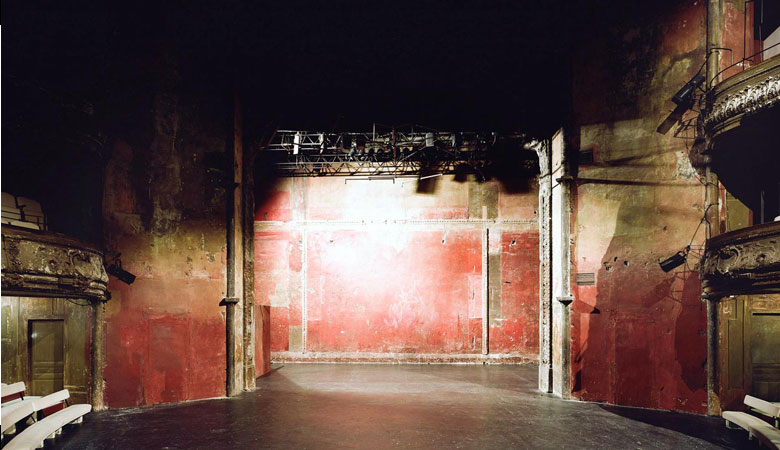Peter Brook and the Bouffes du Nord
On a non-descript street round the back of the Gare du Nord, at first you might wonder how a theatre could sit behind this frontage which looks like any other residential Parisian building – tall windows with metalwork balconies, a café at ground floor. The café was typical Paris –dark bistro chairs, small tables, a traditional bar with a wooden panelled front and mirrored shelves, a menu of cassoulet and steak-frites and salade frisée. It was the front of house for the theatre, but nothing in it spoke of anything that could not be found on any Parisian street.
Going through into the theatre was like stepping through the looking glass. The theatre had been found by Brook in a near-derelict state, and he had done the bare minimum to make it work. It was once an incredibly ornate music-hall theatre, with arches and mouldings and balconies arranged in a perfect oval above which a domed ceiling was decorated with fine metalwork. But the gilt was long gone, the plaster falling down, the original red of the walls was patchy and faded. All of this was left with no repairs made, and only new padded benches – no individual seats – were added, along with lighting bars simply suspended in a practical, visible grid. Most radically of all, the floor was left flat from the stalls all the way to the back of the stage. No division, no looking down or up from audience to actor and no backdrop or wings, just the bare red of the back wall. This was where the company rehearsed, did yoga, sat in a circle to discuss and debate, and performed, standing on the flat floor in front of the simple benches with a minimum of props.
This way of treating a building– to resist tinkering or restoring, and to make the bare minimum of changes with absolute confidence – is something that has stayed with me, although we rarely get the opportunity to be as bold. Working with Brook showed how little needed to be done to make a setting for life to unfold and for people to make connections and tell stories. As architects and planners, that is all we seek to do - make settings for life in all its richness to take hold. Often the site you inherit - like the Bouffes with its plasterwork - is all the ornament and gloriousness you need, and you just need to add the padded benches and leave the floor flat.
I wrote this piece for Building Design magazine as one of two options I gave them for my 'Wonder' - they chose the other one and published my short piece on the Temple Mount / Haram Al-Sharif.
With the recent death of Peter Brook, I noted not much had been said about the building in which he worked. Before I had even considered studying architecture, I was lucky to work with Brook in Paris as a kind of runner, doing whatever needed to be done. I was a musician and had helped out on some small operas; Brook was directing his first opera in decades and he needed someone who could read scores; I had the unearned privilege of being at three degrees of separation through a friend of my mother. Along with his way of working – intensive improvisation for weeks - his theatre, the Bouffes du Nord, was a revelation.
So I thought I'd dig the piece out, rewrite it a little and publish it here as a small tribute to an extraordinary person, who has shaped my perspectives in so many ways.
Comments